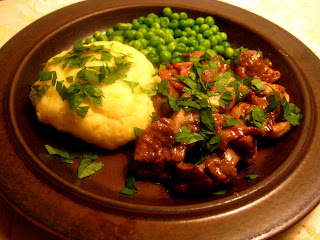About the first thing I ever tried to make was chocolate fudge. Ever since I'd been old enough to go to school fairs by myself, I'd loved buying little cellophane packets of it. When it was good - not too sugary or too hard, no crystals, just pure smooth melt-in-the-mouth chocolateyness all through - it was sensational.
At high school I made it with a friend at her place - she was an expert. But the first, second and third times I tried it at home, the wretched stuff would never set properly. It still tasted good, but I had to eat it with a spoon. So, as I tended to do whenever I encountered anything that I couldn't master, I gave up trying. After all, I couldn't cook anything else, so why should I be able to cook fudge?
In fact fudge is just not that easy to get right, unless you happen to have a confectionery thermometer. It's also not that safe, since it involves coping with a whole pot of boiling sugar. Heaven knows why it's supposed to be something really suitable for children to make.
But one of the things I've decided to do this year is go back to recipes that I've tried unsuccessfully to make in the past, and see if I can get them right, now that I'm a lot older and definitely a bit wiser, at least in terms of cooking. We had a fudge-respondent friend coming for dinner on Friday, so that afternoon, once I had the venison casserole in the oven, I set about making plain chocolate fudge, using a basic recipe devised for Kiwi kids, for "afters". Here's the recipe, with notes of what happened.
Chocolate fudge
(Adapted from
recipe by “Boris” for Kiwiwise)
2 cups sugar
25g butter
1/2 cup milk
1 tablespoon cocoa (I used "dutched" cocoa)
1/8 teaspoon vanilla essence (I slurped in just a little more)
* Lightly butter a tin – a shallow loaf tin is good. It should be the right size to give you a good thick layer of fudge, rather than a thin one.
* Combine all the ingredients, except vanilla essence, in a saucepan, preferably with a heavy base.
The one I used had a good copper base and a double pouring lip, but turned out to be a bit too small – you need to allow enough depth for the boiling fudge to stay well below the rim.
* Gently bring to a light boil. Set the heat low enough to keep the fudge at a light boil for about 20 minutes, stirring occasionally with a wooden spoon.
I have a gas hob, and I think this was partly why I had problems in the past too. Even on a modern hob, using the smallest burner on the lowest setting, I found the mix kept trying to boil over the top of the pan (see above). So I had to keep moving it aside, waiting for it go down, then putting it back. I tried using one of those metal simmer plates, but that slowed it down too much. So I boiled it for an extra 5 minutes, to allow for all this toing and froing.
* Start testing the fudge by dropping a little into a glass of cold water. When it forms a soft ball, instead of just streaming down to the bottom, then it’s ready.
This is the part that used to baffle me. But you can sort of see when it’s reached this stage by the way it drips off the spoon, in solid round drops rather than a little stream, and then it does make a little ball in the water, sort of, though it still plummets to the bottom - somehow I had always imagined it would float.
* Remove from the heat, add vanilla, and beat until thick. Pour into prepared tin and leave to set.
You can use a hand beater, as I did in the past, but it's really hard work, and I probably gave up too soon. This time I did panic mildly, thinking I hadn't cooked it long enough - I'd forgotten how long it took to get thick - but with an electric beater it was much easier. Even so, it needs beating for quite a while, maybe 10 minutes, until it’s obviously getting
really thick. Then it's a race to get it into the tin before it congeals. My tin was a bit too large, so I tried to sort of push it back to form a thicker layer. Then I tried to get the rest of the rapidly setting panful out, and spoilt the lovely smooth shiny top the fudge in the tin had when I first poured it.
* Once it’s set, cut in careful lines, using one steady cut, with a knife heated under the hot tap.
Yes, well. It took at least 3 hours to set properly, and even then the middle pieces were still a bit soft. Unlike my mother I have anything but a "straight eye", so the pieces ended up neither square nor even. But I consoled myself by eating all the by now well-hardened scraps out of the pan and off the beaters. It was definitely a success at dinner - even Harvey had a bit. And as you can see, mine looks no messier, and if anything a bit better, than the fudge on the website (below). Next time I'll try Russian fudge.














